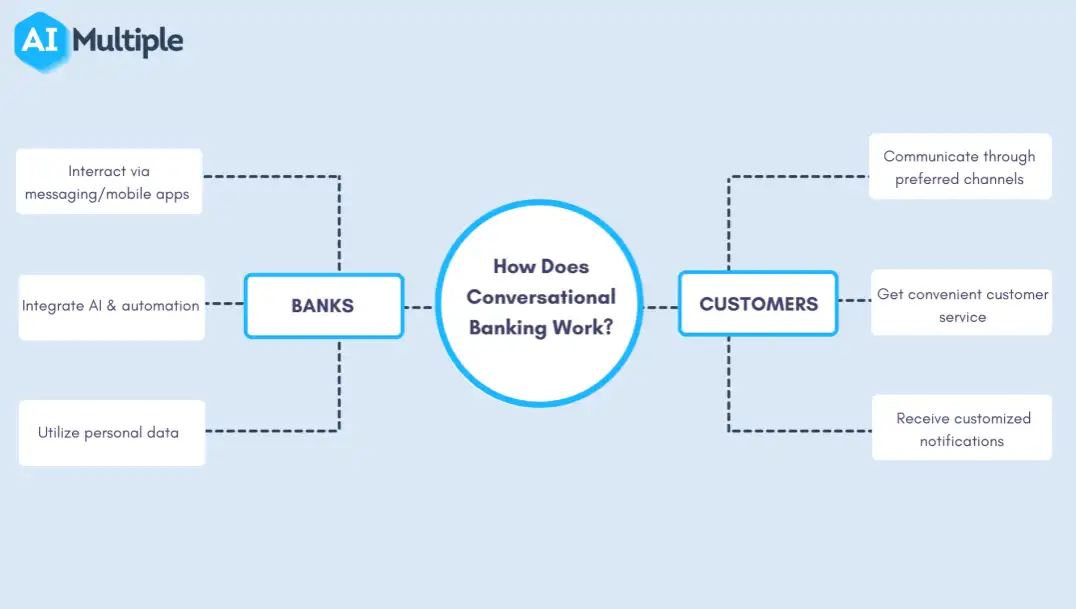Revolutionizing the Banking Experience: The Era of Conversational Banking
In the fast-paced world of finance and technology, the banking sector has undergone a significant transformation. One of the most notable changes is the advent of conversational banking, a trend that leverages artificial intelligence (AI) to enhance customer interactions and streamline banking services.
What is Conversational Banking?
Conversational banking, also called chat banking, is a branch of conversational commerce that aims to mimic offline banking sales experience online and provide a digital communication experience for customer service. It represents a fundamental shift in how customers interact with their banks. Instead of relying on branches or navigating complex mobile apps, customers can now engage in natural, human-like conversations with virtual assistants or chatbots. These AI-driven solutions have become increasingly sophisticated, making it possible to handle a wide range of banking tasks.
Key Benefits of Conversational Banking
Enhanced Customer Experience
- User-Friendly Interface: Conversational interfaces are intuitive and natural, making it easy for customers to interact with their banks without the need for specialized knowledge or training.
- Personalized Interactions: Conversational AI can analyze customer data to provide personalized recommendations and solutions, making each interaction feel tailored to the individual’s financial needs and preferences.
24/7 Accessibility
- Round-the-Clock Service: Virtual assistants and chatbots are available 24/7, ensuring that customers can access banking services whenever it’s convenient for them, including outside of traditional banking hours.
Efficiency and Speed
- Instant Responses: Conversational AI can quickly respond to customer inquiries, perform routine transactions, and provide information in a matter of seconds, eliminating the need for customers to wait in queues or navigate complex menus.
- Task Automation: Many routine banking tasks, such as checking account balances, transferring funds, or paying bills, can be automated through conversational interfaces, saving customers time and effort.
Cost Savings for Banks
- Reduced Operational Costs: Virtual assistants and chatbots can handle a high volume of inquiries simultaneously, ensuring efficient use of resources and cost savings for Banks by reducing the need for physical interfaces.
Improved Customer Engagement
- Proactive Communication: Banks can use conversational AI to proactively engage with customers, such as sending payment reminders, account alerts, or personalized offers.
- Feedback and Surveys: Collecting customer feedback through conversational interfaces can help banks understand customer needs and preferences better.
Reduced Error Rates
- Accuracy: Conversational AI systems are designed to provide accurate and consistent responses, reducing the risk of human errors in routine transactions and inquiries.
Cross-Channel Integration
- Seamless Multichannel Experience: Conversational banking can be integrated with other customer touchpoints, such as mobile apps, websites, and social media, ensuring a consistent and cohesive experience across channels.
Scalable and Adaptable
- Scalability: Conversational AI can handle a growing customer base without a linear increase in resources, making it cost-effective as banks expand their operations.
- Adaptability: Banks can easily update and improve conversational AI systems to incorporate new features, comply with regulations, and meet changing customer demands.
Data-Driven Insights
- Customer Data Analysis: Conversational banking generates valuable customer data that banks can analyze to gain insights into customer behavior, preferences, and pain points, enabling data-driven decision-making and personalized offerings.
Competitive Advantage
- Market Differentiation: Banks that offer advanced conversational banking services can differentiate themselves in a competitive market by providing a more convenient and innovative customer experience.
Use cases of conversational banking with examples
Conversational banking covers a wide range of financial needs and interactions which on the one hand offers customers greater convenience while on the other hand allows banks to streamline operations and increase customer engagement. With further development in technology, the innovative potential of conversational banking solutions will only continue to grow.
- Automated customer service – One of the most customary applications of conversational banking is customer service automation with the help of chatbots and Intelligent Virtual Agents. Bank of America’s virtual assistant “Erica” enables customers to ask questions and get assistance through a mobile app. Customers can inquire about their account balances, and transactions, and even get help with budgeting and financial advice.
- Customer onboarding – Digital Banks and many other financial institutions have automated customer onboarding processes via conversational banking. AI chatbots collect necessary data for onboarding and help in verification of the new customers. This service helps customer satisfaction. For example, Upstox has successfully onboarded more than 220K customers via conversational AI solutions.
- Loan and Credit Applications – Customers are these days able to apply for loans, credit cards, or other financial products by using virtual assistants. These IVAs guide customers through the application process. These chatbots imitate bank staff on digital platforms provide loan support and smoothen the customers’ journey. Furthermore, these mortgage chatbots utilize customer data to make forecasts and produce clients’ credibility reports, which are used by analysts to find potential clients for generating loans or other services. For example, American Express has incorporated chatbots into its customer support services. Customers can inquire about their credit card balances, recent transactions, and even dispute charges through the chatbot. HDFC Bank in India uses its chatbot “Eva” to help customers with queries related to home loans, mortgages, and other financial products.
 Investment Assistance – Virtual assistants improve customer engagement by offering investment and management recommendations. These suggestions help customers to make informed investment decisions. There are two methods available: –
Investment Assistance – Virtual assistants improve customer engagement by offering investment and management recommendations. These suggestions help customers to make informed investment decisions. There are two methods available: –
- Priority Banking or Wealth management chatbots communicate with customers to understand their expected yield and risk attitude and based on the current financial situation they offer them a portfolio.
- On the other hand, chatbots send mass messages to customers with industry news and FI predictions.
For example, Ally Bank’s “Ally Assist” chatbot can provide information on investment options and assist customers in managing their investment portfolios.
 Specific alerts – Conversational banking automates the sending of personalized notifications such as balance notifications, large transactions, two-factor authentication codes for secure payments, due day of debt payments etc.
Specific alerts – Conversational banking automates the sending of personalized notifications such as balance notifications, large transactions, two-factor authentication codes for secure payments, due day of debt payments etc. Fraud Detection – There are a lot of AI-driven tools that help in detecting and preventing fraud. Banks, credit card, and finance companies send customized transaction-related notifications. Customers get the opportunity to confirm whether transactions are fraudulent, credit cards are stolen, etc., and get the opportunity to block the credit cards right away or restrict the ability to money transfer. Conversational AI chatbots are sharp at classifying and analyzing suspicious activities. For example, Royal Bank of Scotland (RBS) uses a chatbot to alert customers about potentially fraudulent transactions, helping enhance security and prevent unauthorized use of accounts.
Fraud Detection – There are a lot of AI-driven tools that help in detecting and preventing fraud. Banks, credit card, and finance companies send customized transaction-related notifications. Customers get the opportunity to confirm whether transactions are fraudulent, credit cards are stolen, etc., and get the opportunity to block the credit cards right away or restrict the ability to money transfer. Conversational AI chatbots are sharp at classifying and analyzing suspicious activities. For example, Royal Bank of Scotland (RBS) uses a chatbot to alert customers about potentially fraudulent transactions, helping enhance security and prevent unauthorized use of accounts.
The Future of Conversational Banking
According to Analytics Insight, the global artificial intelligence market for the banking sector is expected to generate $48.3 billion in sales by 2025. As AI technology continues to evolve, virtual assistants and chatbots will become even more intelligent and capable. Here are some potential developments:
- Greater Personalization
- Conversational AI will become even more adept at analyzing customer data to provide highly personalized banking experiences, offering tailored product recommendations, financial advice, and solutions that match individual preferences and goals.
- Advanced Natural Language Processing (NLP)
- Improved NLP models enable virtual assistants and chatbots to understand and respond to complex and nuanced customer queries, leading to more sophisticated conversations and problem-solving capabilities.
- Voice Biometrics and Security
- Voice recognition and biometrics may further play a crucial role in enhancing the security of conversational banking, allowing for secure voice-based authentication and transaction verification.
- Integration with Emerging Technologies
- Conversational banking integrated with emerging technologies like augmented reality (AR) and virtual reality (VR) will offer innovative and immersive banking experiences, such as virtual branch visits or 3D data visualizations.
- Cross-Platform Integration
- Banks may use conversational banking to seamlessly integrate with various channels, including mobile apps, websites, social media, and smart home devices, to provide customers with consistent and convenient access to services.
- Wider Range of Services
- Conversational AI may expand its capabilities to handle more complex financial tasks, such as mortgage approvals, investment portfolio management, retirement planning, and even legal or tax advice.
- Emotional Intelligence
- AI-driven virtual assistants may be equipped with emotional intelligence features, allowing them to recognize and respond to customer emotions, thereby enhancing the overall customer experience.
- Global Expansion
- As language capabilities improve, conversational banking may become more accessible to customers worldwide, offering support in multiple languages and catering to diverse cultural preferences.
Conclusion
Conversational banking is reshaping the banking industry, offering customers a convenient and personalized way to manage their finances. While challenges exist, banks that successfully implement and adapt to this technology stand to gain a competitive edge in an increasingly digital world. As conversational AI continues to evolve, it will play a pivotal role in the ongoing transformation of the banking sector, ensuring that financial services remain accessible, efficient, and customer-centric.




Comments are closed.